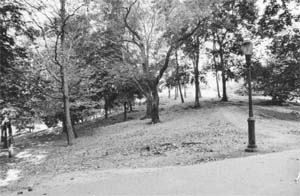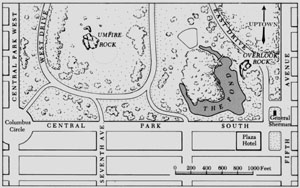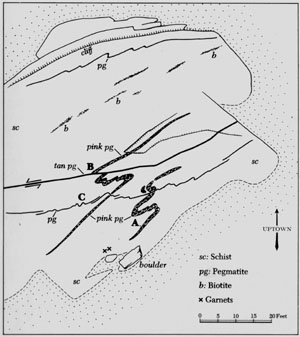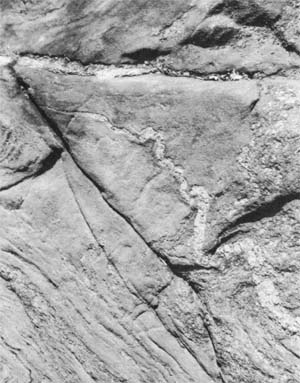
| Home | Tours/Lectures | Books | Maps | Posters | Pictures | Contact |
TABLE OF CONTENTS Before You Start Introduction Tour I: From Dene to Green Tour II: Overlook Rock Tour III: Umpire Rock Tour IV: Belvedere Lake Tour V: Woodland and Waterside Glossary |
TOUR II: OVERLOOK ROCK
ENTER the park at 59th Street just off Fifth Avenue, in line with the front of the Plaza Hotel and on General Sherman's right. Take the path that runs along the west side of East Drive and follow it north past an iron rail fence. At the next lamp post on the left, leave the path and walk up the slope to the northwest. Try to choose a day when the ground is firm and dry in order to spare your shoes and what remains of the grass.
The outcrop that forms the hill is outstanding for the beautiful color and design of its igneous intrusions. The patterns, which suggest jet trails crossing streamers of sunset cloud, might inspire a mural for an air terminal. In this outcrop, successive waves of molten material are distinguishable by their different colors, so the sequence of their entry is easy to read.
 |
| Approach to Overlook Rock. |
As you approach, keep close to the right of the loose boulder and walk to the top of the rise where you will find a swirling ribbon of pegmatite glinting with large flakes of silvery mica and pink microcline (A). This intrusion, which conforms to the layering of the host rock and shares the same intense folding, flows off to the east.
 |
| Overlook Rock (Tour II) and Umpire Rock (Tour III). |
Another pink layer, eight feet to the north of the first one, starts out as a bold S curve but is broken by a tan dike (B) which cuts across it. The pink layer reappears on the far side at least two feet to the west of its original alignment. The strong, folding of the pink band indicates that it entered the schist while deformation was still in active progress. Millions of years later, when the schist had cooled enough to crack under stress instead of bending, it fractured across its grain and one or both sections were moved bodily from their former position. The offset in the pink pegmatite records the extent of displacement. The fracture was subsequently filled and perbaps widened by a forcible intrusion of molten rock, this time pegmatite of a light tan rather than the usual pink color. Because the host rock had nearly solidified, the later intrusion is only slightly bent out of line.
 |
| Map of Overlook Rock. |
As you stand on the offset in the pink layer, look a little west of south towards the highest point of the outcrop. On its slope, eleven feet from the off set, you will see a little darting figure (C) -- a sharp-nosed dragon? a flying serpent? -- so expressive of dashing speed that it would serve as insignia for a telecommunications company. There are other patterns to stir your imagination if you stroll over the outcrop in a receptive frame of mind.
 |
| The "dragon" on Overlook Rock. |
Be sure to include the extreme northeast corner of the outcrop in your survey, as it contains a mineral not so readily identifiable at any other stop. This is biotite or black mica, here displayed in raised black lines of varying thickness. The crystals are uptilted so that only their thin edge is visible, but if you search closely, you may be able to pick out a gleaming flat surface. As we saw on the first tour, strata containing a large proportion of white mica are porous and markedly susceptible to frost wedging and erosion. Black mica must be more resistant -- perhaps its crystals are more tightly pressed together -- as these lines stand up above the eroded surface of schist much like the hairline ridges of quartz noted at the Balto stop.
As you leave the outcrop on the south side, turn back and sight along the southwest side of the boulder. If you follow this line to the slope of the outcrop, you may discover some garnets embedded in the schist a foot or two above its base. The crystals appear in clusters and look a bit like small raspberries except for their deep oxblood red color. If you want to clinch the identity of the stones, draw a piece of clear glass over them. On a comparative scale of hardness topped by diamonds at 10, garnets stand at 7 and will scratch glass just as diamonds do.
Garnets, when mined in quantity, are used commercially as an abrasive. Garnet paper, tougher and more durable than ordinary flint sandpaper, is valued for use in fine woodworking. These few flawed, uncut garnets have no value except as agreeable curiosities in the Central Park landscape, so leave them in place for the next explorer. Don't fret if you can't find them. There are others, more easily located though of less rich color, to be found on the Ramble tour.